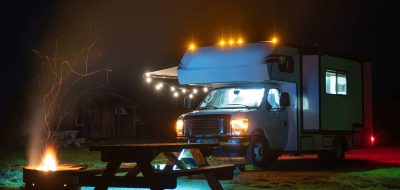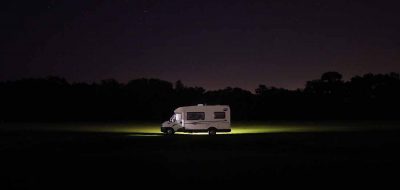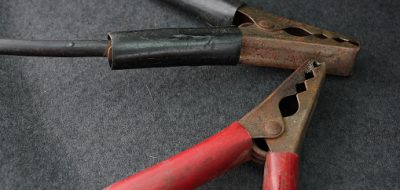By Bob Difley
Things change, in fact they have changed a lot–especially in the technological products available for RVers–since I first started RVing more than 40 years ago. I struggled in my early days of RVing with keeping my batteries charged, the annoying drone of what at the time seemed to be the endless running of my generator trying to re-charge those batteries, and still find electricity to be somewhat mystical.
So I was interested when I discovered Chris Dunphy & Cherie Ve Ard, a couple wandering America in their 1961 bus conversion. On their website, titled Technomads: Technology Enabled Nomads, they describe their current state as “exploring the confluence of full-time travel, technology, career, and community; all while embracing nomadic serendipity”.
It could be said that all of us boondockers and fulltimers are seeking “nomadic serendipity” but Chris and Cherie are putting together their version in large part with the help of combining standard technology with cutting edge technology developments to create and operate the best, most efficient, resource and environment friendly electrical system possible for their bus. And they write with clarity and knowledge about their efforts along with real time examples of their efforts.
I was especially fascinated with what they had to say about “boosting inverters”:
Boosting Inverter = Smaller Generator
RV generators have traditionally been sized so that they can handle the absolute peak load that they might ever need to power – in particular, the surge current of multiple roof air conditioners turning on at once. You thus end up with 7,000W – 15,000W generators typically running at a fraction of their capacity, only rarely ever even approaching full power.
If you instead use a boosting inverter to handle spikes in demand, you can get by with a much smaller, cheaper, and more fuel efficient generator. It is a win all around, and the money you save by going with a smaller generator will likely more than cover the cost of a more capable inverter.
Cummins Onan has even embraced this design philosophy in their new flagship hybrid generators, bundling a matched inverter / charger right with the generator itself. (Photo at left – Onan HQD810 Hybrid Genrator, a 7,500 watt generator that uses a paired inverter to boost it to 10,000 watts.
You wonder why you don’t see more about boosting inverters or hybrid generators, and Chris offers a reason–and some examples–for that also:
The reason that so few companies have offered “boosting” is because so few people have really understood the benefits of it. So let me give a few examples from our past few months in Florida where being able to boost literally improved our views.
#1 – We spent the month of January staying on a friend’s absolutely beautiful patch of land in Kissimmee, with the only available source of power being a single outdoor outlet 50 yards away. By dialing our shore current limit down to 15 amps we were able to keep from blowing fuses, and thanks to boosting we were even able to run our electric heater on the coldest nights. In the morning the batteries would get charged, making up for the drain in the evening. Without our boosting inverter, we would have had to go without heat, or stay in a drab commercial RV park.
We love staying with friends whenever possible, and having a boosting inverter makes this vastly easier than it would be otherwise.
#2 – Just this week we have been staying at a commercial RV park on the water in Cedar Key, FL. Though we have a 30-amp outlet available, to reach it with our shore power cord we have to park the bus rear-end towards the water. But since we can get by with 15 amps thanks to boosting (and can even run the AC during the heat of the day!), we have been able to use a common heavy duty extension cord to allow us to plug in and park the bus nose in. (Sure we could carry around a huge and expensive 30A extension cord, but the bulk wouldn’t be worth the rare times that we’d actually be able to use it…)
Thee current article on their Technomadia website goes into more detail on the subject of converters, inverters, and inverter/chargers with special emphasis on boosting inverters.
For more RV tips and articles, check out my Healthy RV Lifestyle website where you will find my ebooks: BOONDOCKING: Finding the Perfect Campsite on America’s Public Lands, 111 Ways to Get the Biggest Bang out of your RV Lifestyle Dollar, and Snowbird Guide to Boondocking in the Southwestern Deserts (PDF or Kindle).







Doug
It’s simple, really. You cannot use a typical inverter and shore power / generator at the same time. But you can with a BOOST inverter. This allows your RV’s batteries to compensate for an undersized generator or inadequate shore power. Right now this technology is new and way overpriced, but expect to see more common inverters offering the boost feature in coming years.
Chris
I’m confused is this technology similar to what I have in my inverter generator? (yamaha 2000is)
LARRY D
SOUNDS LIKE JUST A CURRENT LIMITING DEVICE TO KEEP FROM OVERLOADING YOUR GEN OR REQUIRING A HEAVIER EXTENSION FOR SHORE POWER
Geoffrey Pruett
A large improvement in length of time to charge batteries can be accomplished with a next generation converter ( ACtoDC) which charges the batteries at the proper voltage instead of a “hold charge” like the older style. This is one of those items best done by a pro! Unless the wiring is done correctly there is little to be gained. The difference between a real charge level and a “hold charge” is under 3 volts and the drop between the converter and the battery bank must be figured in to get best results. The plus side is that your rig can be plugged in all the time without battery damage. You still need to check the fluid levels if using that type of battery but losses should be nominal. The change is impressive. Figured this our from noting that a short trip, 25 miles, meant generator next day, 200 miles meant maybe three days until batteries were down. Most RV centers can do this but be sure they have an electrical specialist on staff, it is not a plug and go item?
Ron Butler
Hmm – sounds interesting even if I didn’t understood it!! I’m sure Bob’s description was spot on, but once you get past of telling me to plug it in and flip the switch any further attempts to explain the process to me only makes my eyes glaze over!
Guess I will go to their website and see if I can get past the first paragraph!
Keep on explaing for us technically challenged ones, Bob!
Donald Warne
Thank You Butterbean! I thought it was me. Does sound interesting though–I think.
don
butterbean carpenter
Howdy guru,
I wish I understood what you’re talking about, because it sounds good when you say it!!